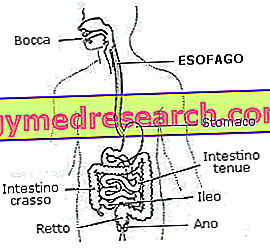See also: Barrett's Esophagitis Esophagitis
The esophagus is the tract of the alimentary canal that unites the pharynx with the mouth of the stomach. This muscular conduit extends between the sixth cervical vertebra and the tenth thoracic vertebra, for a total length of 23-26 centimeters; its thickness, at the point of greatest diameter, reaches 25 - 30 millimeters, while in the narrower one it measures 19.
During its course, the esophagus draws relationships with numerous anatomical structures, among which we remember the trachea, the thyroid lobes and the heart, anteriorly, the vertebral column posteriorly, and the diaphragm, which crosses at a small opening called the

The esophagus is comparable to a connection tube - with an almost vertical course similar to an elongated S - which allows food to descend from the mouth to the stomach (anterograde transport) and vice versa (retrograde way during eruption and vomiting).
The functions of the esophagus, however, are not limited to simple transport; very important, for example, is the lubricating activity, which makes it possible to keep its internal walls moist, facilitating the descent of food. The esophagus, moreover, thanks to the presence of a sphincter by extremity, is opposed to the entry of air into the stomach during breathing and to the ascent of the gastric contents into the oral cavity.
The passage of the food bolus from the pharynx to the esophagus is regulated by the upper esophageal sphincter.
The passage of the food bolus from the esophagus to the stomach is regulated by the lower esophageal sphincter.
A sphincter is a muscular ring with a tone so accentuated that it remains in a state of continuous contraction; this state can be modified by voluntary mechanism (external anal sphincter) or reflex (like the two sphincters of the esophagus).
The upper esophageal sphincter participates in the swallowing function, opening to allow the pharynx to push the bolus into the esophagus; in resting conditions the musculature that constitutes it is contracted and the sphincter remains closed, preventing the passage of air into the digestive tract and inhaling food into the airway.
As mentioned, the esophagus has a muscular wall consisting of two structures: a longitudinal external muscular layer and an inner circular layer. The latter is entrusted with the propulsive activity, which allows him to perform very important movements of peristalsis. As a segment of upstream musculature contracts, the downstream stretch relaxes; subsequently this will contract and so on, with succession from top to bottom until the complete descent of the food bolus into the stomach. Esophageal peristalsis is facilitated by the lubricating action of saliva and esophageal secretions.
When the peristaltic wave hits the lower part from the esophagus, a relaxation of the lower sphincter (called cardias) is produced with consequent entry of the bolus into the gastric sac. At the end of this phase, the cardias regains normal hypertonus and prevents the ascent of the gastric contents into the esophagus. If the lower esophageal sphincter does not have a sufficient tone, gastric juices and pepsin can rise from the stomach causing the so-called gastroesophageal reflux. It is a rather common and annoying disorder, since these substances strongly irritate the esophageal mucosa triggering pain and heartburn (burning sensation).
The inner walls of the esophagus are lined with the mossy cassock, a multilayered epithelium that often protects it from the transit of food (which may have pointed ends or particularly hard residues). Within certain limits, this effective barrier also protects it from physiological acid reflux, which appears, especially after meals, a little in all people.
When the cardia, which is normally located below the diaphragm, enters the esophageal hiatus going up into the thoracic cavity, we speak of a slipping hiatal hernia, an ever increasing disease especially in people over 45-50; its symptoms are similar, but generally more severe, than those of gastroesophageal reflux.



